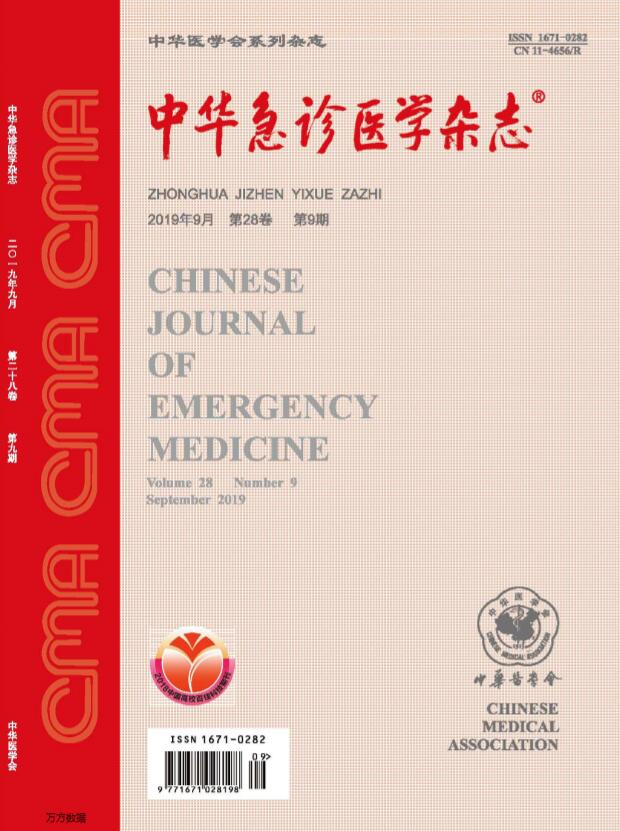The early diagnosis and therapy of septic shock caused by soft tissue infection
Q4 Nursing
引用次数: 0
Abstract
Objective To assess the prognostic accuracy of the quick Sequential Organ Failure Assessment (qSOFA) score for septic shock of adults with soft tissue infections. The clinical characteristics of these patients were analyzed to provide reference for their multidisciplinary treatment. Methods A retrospective study was conducted. The patients with soft tissue infections admitted to the General Surgery Department of Beijing Hospital and the Burn and Plastic Surgery Department of Fourth Medical Center of PLA General Hospital from January 2012 to December 2018 were enrolled and patients combined with other infections were excluded. Patients were divided into the septic shock group and the non-septic group according to whether septic shock occurred during hospitalization. The baseline data, non-operative management and prognosis were compared between the two groups with Fisher's exact test. The sensitivity, specificity, positive predictive value, negative predictive value and the area under the receiver operating characteristic curve (AUC) of the qSOFA for diagnosis of sepsis and septic shock were calculated. Patients were also divided into four groups according to the etiology of soft tissue infection. The pathogens, surgical treatment and morbidity of septic shock among the four groups were also compared. Results A total of 192 patients were enrolled, including 28 (14.6%) patients with septic shock. Compared with the non-septic shock group, there were more proportion of patients with qSOFA≥2 (60.7% vs 18.3%, P=0.001) within 24 h of diagnosis of infection, and higher morbidity of sepsis (82.1% vs 32.9%, P<0.01) within 48 h of diagnosis of infection in the septic shock group. At the cut-off value of qSOFA≥2, the sensitivity, specificity, positive predictive value, negative predictive value and the AUC were 60.7%, 81.7%, 36.2%, 92.4% and 0.767 (95%CI: 0.665-0.869, P<0.01) respectively for diagnosis of septic shock. The morbidity of septic shock (36.4%) and 28-day mortality (13.6%) in patients with necrotizing fasciitis were higher than those in patients with other causes (both P<0.05). The most common pathogens were methicillin-sensitive Staphylococcus (6.8%), methicillin-resistant Staphylococcus (6.2%), Enterobacter (5.7%) and Enterococcus (5.2%). Conclusions qSOFA≥2 can be used as a rapid septic shock screening tool for adults with soft tissue infection. Early diagnosis of sepsis, thorough debridement and effective antibiotic treatment are essential for these patients. Key words: Skin soft-tissue infection; Sepsis; Septic shock; Quick Sequential Organ Failure Assessment软组织感染致感染性休克的早期诊断与治疗
目的评价成人感染性休克合并软组织感染的快速顺序脏器功能衰竭评分(qSOFA)的预后准确性。分析这些患者的临床特点,为其多学科治疗提供参考。方法回顾性研究。选取2012年1月至2018年12月在北京医院普外科和解放军总医院第四医疗中心烧伤整形外科住院的软组织感染患者,排除合并其他感染的患者。根据住院期间是否发生脓毒性休克分为脓毒性休克组和非脓毒性休克组。采用Fisher精确检验比较两组患者的基线资料、非手术治疗及预后。计算qSOFA诊断脓毒症和感染性休克的敏感性、特异性、阳性预测值、阴性预测值和受试者工作特征曲线下面积(AUC)。根据软组织感染的病因将患者分为四组。比较四组患者感染性休克的病原菌、手术治疗及发病率。结果共纳入192例患者,其中感染性休克28例(14.6%)。与非感染性休克组相比,感染性休克组在感染诊断后24 h内qSOFA≥2的患者比例更高(60.7% vs 18.3%, P=0.001),在感染诊断后48 h内脓毒症的发病率更高(82.1% vs 32.9%, P<0.01)。在qSOFA≥2的临界值下,诊断感染性休克的敏感性为60.7%,特异性为81.7%,阳性预测值为36.2%,阴性预测值为92.4%,AUC为0.767 (95%CI: 0.665 ~ 0.869, P<0.01)。坏死性筋膜炎患者脓毒性休克发生率(36.4%)和28天死亡率(13.6%)高于其他原因的患者(P<0.05)。最常见的病原菌为甲氧西林敏感葡萄球菌(6.8%)、耐甲氧西林葡萄球菌(6.2%)、肠杆菌(5.7%)和肠球菌(5.2%)。结论qSOFA≥2可作为成人软组织感染感染性休克的快速筛查工具。早期诊断败血症,彻底清创和有效的抗生素治疗对这些患者至关重要。关键词:皮肤软组织感染;脓毒症;脓毒性休克;快速顺序器官衰竭评估
本文章由计算机程序翻译,如有差异,请以英文原文为准。
求助全文
约1分钟内获得全文
求助全文
来源期刊

中华急诊医学杂志
Nursing-Emergency Nursing
CiteScore
0.10
自引率
0.00%
发文量
8629
期刊介绍:
Chinese Journal of Emergency Medicine is the only national journal which represents the development of emergency medicine in China. The journal is supervised by China Association of Science and Technology, sponsored by Chinese Medical Association, and co-sponsored by Zhejiang University. The journal publishes original research articles dealing with all aspects of clinical practice and research in emergency medicine. The columns include Pre-Hospital Rescue, Emergency Care, Trauma, Resuscitation, Poisoning, Disaster Medicine, Continuing Education, etc. It has a wide coverage in China, and builds up communication with Hong Kong, Macao, Taiwan and international emergency medicine circles.
 求助内容:
求助内容: 应助结果提醒方式:
应助结果提醒方式:


